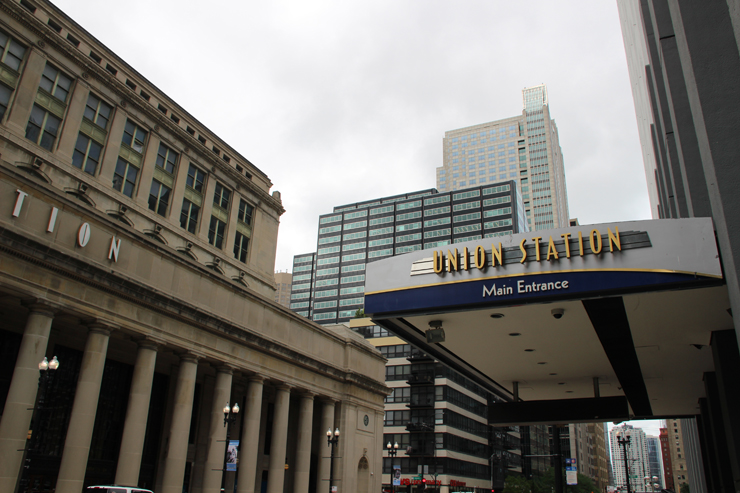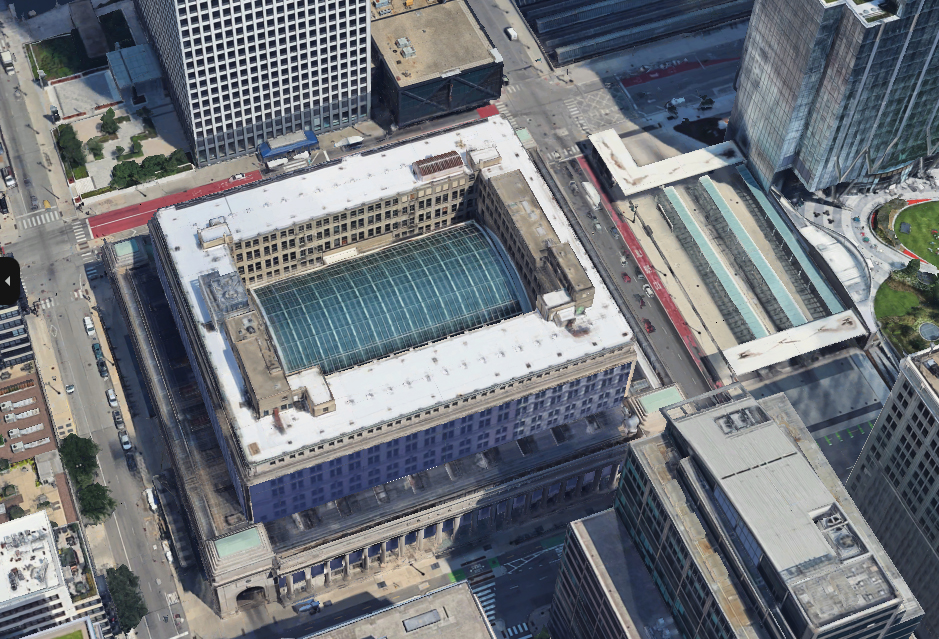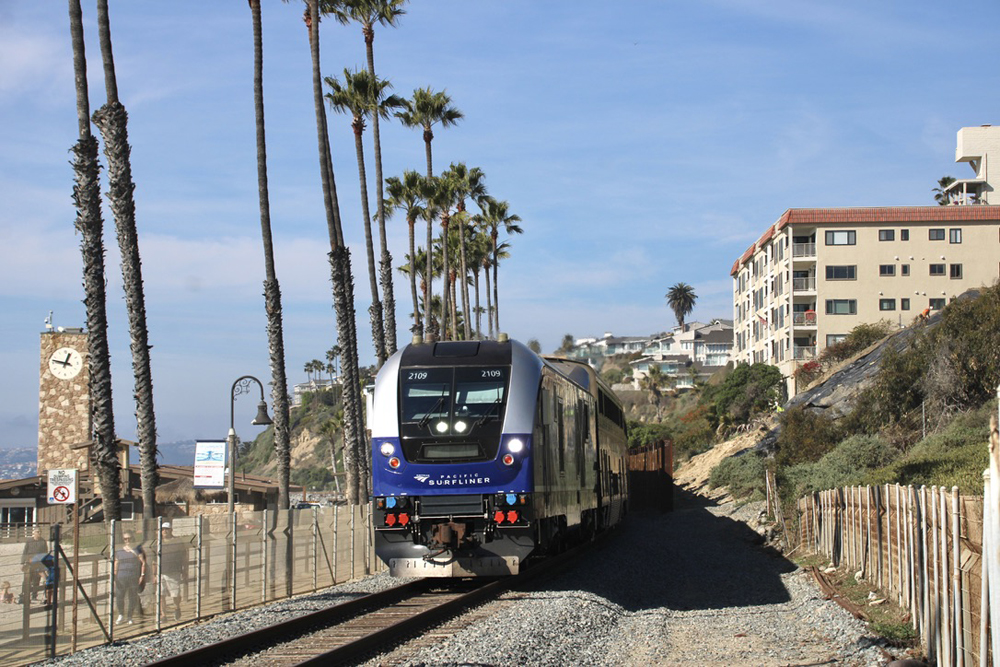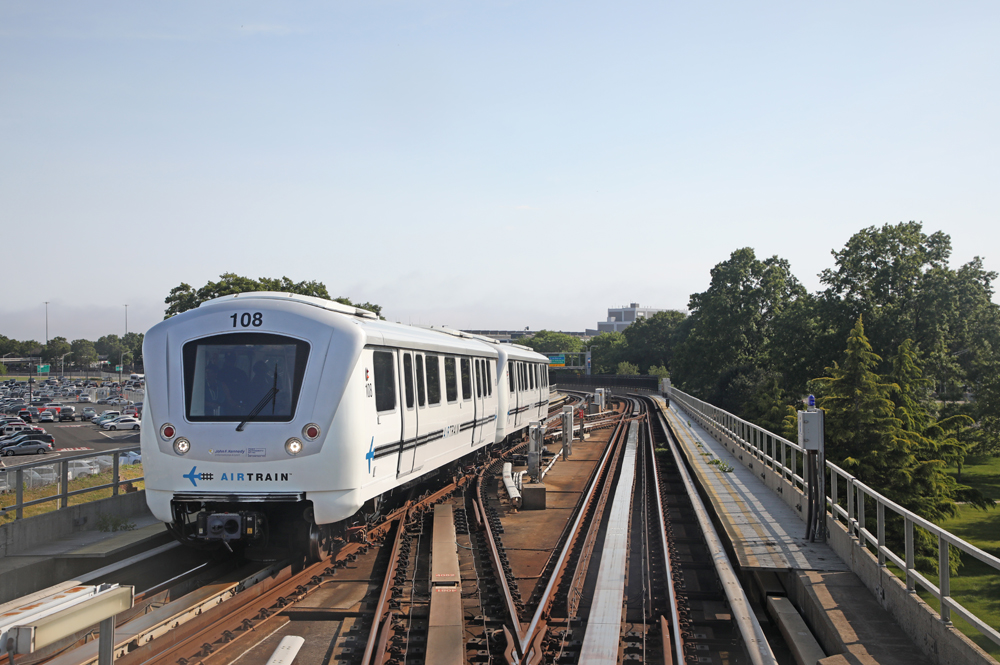
CHICAGO — The city of Chicago wants Chicago Union Station to provide waiting-room space for Greyhound bus passengers after the expected closure of the city’s Greyhound station in mid-September, the Chicago Sun-Times reports. But Amtrak — Union Station’s owner — says it hasn’t been contacted about any such plan and has reservations about the area’s ability to handle the additional street traffic Greyhound would generate.
Greyhound’s lease on its current depot at 630 West Harrison Street ends soon, and the company could have to vacate the space by mid-September. The city’s chief operating officer, John Roberson, told the Sun-Times that having passengers board buses at the Chicago Transit Authority transit center at Canal Street and Jackson Boulevard, across the street from Union Station, “is the best option from the city’s standpoint.” That would allow passengers to wait at Union Station and use its restrooms, and Greyhound already has a ticketing kiosk at the station. However, nothing is final; the city, CTA, and Greyhound owner FlixBus are still negotiating; among other issues, Greyhound would have to adjust its schedule around the CTA’s.
This would be a short-term solution, Roberson said, while the city seeks to develop a bus station elsewhere.
Amtrak, however, made it clear in a statement issued today that it sees problems with the plan.
“Amtrak recognizes the need for a permanent intercity bus transit center location in the City of Chicago,” the statement reads. “We currently provide access to Greyhound buses connecting to Amtrak trains and are happy to participate with stakeholders as they consider options for a future facility.
“That block of Jackson Boulevard is already very congested and Chicago Union Station is already uncomfortably crowded. This situation worsened when Canal Street access was lost to a major city street reconstruction project. Adding dozens of intercity buses to Jackson Boulevard and saying hundreds of daily intercity bus users can take shelter in Union Station starting next month are both highly problematic suggestions the city has yet to present to us.”
A 2023 report from DePaul University’s Chaddick Institute for Metropolitan Development called for city action to prevent the closure of the current Greyhound depot, noting that it handles 55 buses daily and handles about 500,000 annual passengers. Those passengers are disproportionately low income, unemployed, disabled, or lack access to private vehicles, and will suffer if operations shift to a curbside location without a secure, climate-controlled waiting room, the paper concluded.
A coalition of some two dozen civic groups has urged the city to buy and maintain the current Greyhound depot, saying in a July letter that “without prompt action, Chicago is headed for a crisis this autumn.” The letter estimates the cost of purchasing and remodeling the station is “less than $40 million — a small fraction of what we regularly spend on major transit, airport, and highway improvement.” But the city says it found a purchase was not financially feasible because of the upgrading costs, and failed in its bid for a federal grant to help buy the facility.















Making Union Station an intercity intermodal station would make good sense, Amtrak should be cooperative in the project. If not congress who keeps them in operation should insist on it and fund any infrastructure needed to make it happen.
In California, a number of RR routes are extended with Amtrak Thruway Bus Service:
https://www.pacificsurfliner.com/plan-your-trip/connections/bus-connections/
Harrisburg PA’s PRR (AMTK) Station is also the intercity bus station with multiple connections via Greyhound and Fullington Auto Bus Co. that you didn’t know about.
https://www.penndot.pa.gov/TravelInPA/PublicTransitOptions/Bus/Documents/Intercity_Bus_Routes.pdf
Megabus parent company Coach filed bankruptcy a few months ago, Megabus was launched with big fanfare it was suppose to be low cost competition for Greyhound. Apparently that wasn’t enough. Busses don’t tap the truly isolated towns off the interstate they just serve the communities on the interstates & as another commentor stated they don’t even go into the towns opting for truck stops along the interstate.
Megabus doesn’t do local runs. They may service several larger towns or smaller cities along the way but that’s it. They basically have no station costs. We have 2 of their runs through our town, via a larger shopping mall just off the interstate, with 2 trips each. They seem to be pretty full when they stop so I assume they are doing OK for our runs. I know that all the types of bus companies in our area have been hit hard by fuel costs and other inflation of expenses so maybe that’s behind some of their problems.
This should go forward. Greyhound and other bus routes can complement Amtrak service. They serve cities and towns Amtrak does not. Good connections should help both companies as well as encourage using public transit instead of driving. The location also provides good local CTA or METRA local routes for connecting passengers.
Better not to condemn a whole city for the actions of a corrupt corporation, even tho’ Chicaga’s history is problematic….a bit of trivia…I had a great uncle, who after getting his PhD under the legendary Robt. Hutchens at the U. of Chicago was immediately hired by the Union League Club as the director of civic affairs. At this point in the 1930’s, the Union league’s mission was to battle civic corruption. So my uncle did battle for half a century. While it may have been a Sisyphesean task, corrupt pols knew powerful reformers were watching. You can look him up: Edward Moss Martin.
Greyhound is but a shell of the bus company I knew in my younger days. Many communities the bus stop tends to be at a gas station or truck stop at a convenient freeway exit. Many of the larger city terminals are no longer maintained or financially viable. Or, as is the case in Chicago, prime property for development. I know the Greyhound station in Cleveland has developers frothing at the mouth. The desire is to create an intermodal terminal in Cleveland but there is no money. Toledo did get a decent remake of the train station for Greyhound to move in. But the service is sparse and no longer staffed by Greyhound. The Subway restaurant in the station, I believe, is subsidized by the Port Authority and Subway employees are responsible for janitorial services. Which they do a good job of. Lets admit it. We as a nation have dropped the ball when it comes to integrating all forms of public transportation.
The death of Greyhound started in 1985 when the former CEO of Trailways did a leveraged buyout. Using that buyout he created a parent company and started “diversification” by using Greyhound’s massive pension fund as leverage to buy out Dial Soap and other consumer products. (Buses and Soap, go figure)
Then the new “GreyhoundDIal Corporation” had no need for a busing business (and their pension fund) and spun them off. It served its purpose, it was used as a way to fund the executives way into consumer products.
The result? Greyhound has been through 3 bankruptcies and countless reorganizations and been bought out several times.
What became Dial Corporation got sliced and diced by their management until it was sold to Henkel in Germany.
The problem rests with the Chicago city government. Specifically, it rests with Chicago’s city planners. The notion of an inter-modal transportation hub is nothing new. And since the trains are harder to relocate than the buses, there should have been plans in place ages ago to locate the inter-city buses nearby to Amtrak and the CTA buses and elevated trains. Don’t make your failure to plan Amtrak’s headache. Put a Greyhound waiting room in City Hall. The passengers can chit-chat with the mayor while they await their buses.
“Put a Greyhound waiting room in City Hall. The passengers can chit-chat with the mayor while they await their buses.”
Very good! Love it.
The Dog (and Peter Pan) abandoned their station in Philly, which had been adjacent to SEPTA’s Market East/Jefferson Station, in favor of street loading on Market St. The intercity buses immediately created a traffic problem on a street with multiple SEPTA city and NJT suburban routes.
The City forced them to an inconvenient space in the Northern Liberties still with no waiting room or plumbing. The neighborhood is partially residential and the residents want them GONE.
They’re now looking at parking garage owned by NPS. It was built to take buses.
Yet another example of the incompatibility of the imperatives of 21st century private equity (buy a company, sell the assets, lease back the bare minimum to function, wait, throw up your hands) with the real world the rest of us have to live in.
Is their any limit to either the incompetence or the depravity of Chicago’s city government? No, there isn’t.
Given the current city administration, the only part of Chicago I want to see is the inside of Union Station, where I go to change trains. Now the city wants to take that away from me as well.
Before this mayor (or maybe his immdiate predecessor), Mrs. L. and I would frequently visit Chicago. We used to love that city. No longer.
Greyhound is the cause of this problem. They were the owners and sold it off and leased it back. Now the current owners want to redevelop the property. Yes, a decent intercity bus station is desirable but again, Greyhound sold it off to make money and now it becomes the city’s problem. Hopefully wherever this ends I hope that Greyhound would have to pay sufficient rent to pay for any needed upgrades.
The Bus companies that are doing better are the ones who don’t have big bucks invested in station facilities. That’s why Greyhound got rid of as many of its owned stations as it could.
I have trepidation about Greyhound sharing space at Chicago Union Station. The facilities established by Greyhound have become magnets of crime in recent years.
Greyhound deserted a large terminal inherited from Trailways in Downtown Houston last year (1923) for a small station at a remote location on the east side of town near the East Freeway (I-10). Residents in the area complain about the increase in crimes.
Greyhound stations are deposit points for parolees and ex-convicts.